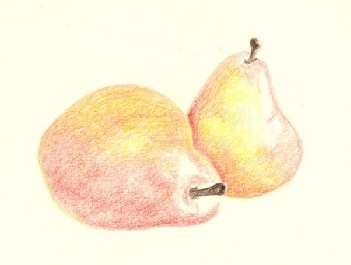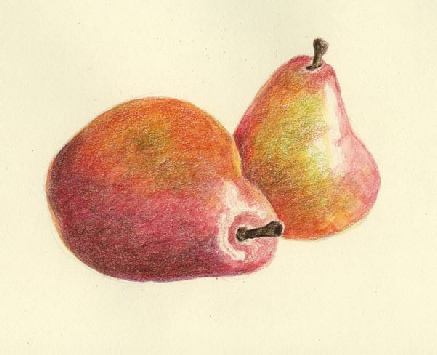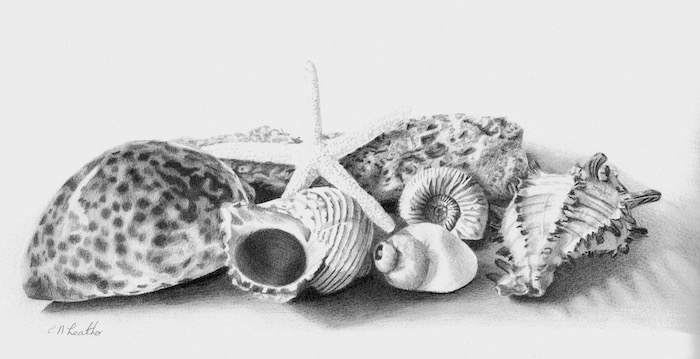- Home
- Watercolor Pencils
- Pear tutorial
Using watercolor pencils for beginners
Two pears - a simple exercise
This exercise in using watercolor pencils, covers the basics without needing any complicated drafting skills. Peter taught this lesson at workshops for several years.
The original reference was not one of his own images, and probably came from a free image library. If you know the source and can let us know, we will acknowledge it here.
 Pears reference photo
Pears reference photoYou will need...
- Hot pressed watercolour paper around 300gsm - fairly thick and relatively smooth
- A small set of watercolor pencils - Staedtler Karat pencils were used here
- A watercolour brush
Colours Used
- 001 Yellow (light yellow)
- 029 Carmine (dark red)
- 076 Van Dyke Brown (a dark red/brown)
- 057 Olive green (a brownish green)
- 006 Violet
- Mid grey
Using watercolor pencils lesson
To begin this lesson in using watercolour pencils start with a small piece of paper and lightly draw the shapes of the pears. You can use a graphite pencil but when using watercolour pencils a grey pencil would be better. If you have a problem drawing the shapes, first draw two circles for each pear, and join up the sides. Erase any lines you don't need and you are ready for colour!


Using two dry pencils (first yellow and then a dark red) lightly shade in a layer of color, keeping all your lines curving in the direction of the shapes and keeping clear of areas of shine which will stay white.
Remember when learning how to use watercolour pencils that two light layers is better than one heavier covering!

Once you have covered the pears with a first full layer you can add the stalks with a dark brown.

Add a further layer of the yellow and dark red, using small, light, circular strokes and making sure your scribbles keep to the shape of the pears.
Save your heaviest strokes for the darkest areas. Look at the photo and you will see that the area of darkest shadow is as dark as the stalks. This is where you are going but there are a few stages yet.

We can now take a damp watercolour brush and merge these colours - keeping clear of the areas of shine. Work from light areas to dark and don’t get your paper too wet. Your brush should follow the lines of the pear skin. It may help you to use a dabbing motion with the brush and keep wiping it on a scrap of kitchen roll to remove excess colour.
The colour is now much more intense, and forms the base for more layers of dry pencil.

Allow your artwork to dry thoroughly before moving on. If you feel that your colour base is still too light, you can add a further process, repeating the stages above.
We can now add more layers of dry colour.
The aim now is to build up depth of pigment on top of the tinted paper surface.
At this point we could move over to wax based coloured pencils as we are not going to use any more water, but for this exercise I am using the Staedtler karat pencils throughout.
After layers of red and yellow again, we can add some violet (No 6 and Olive Green ( No 57).
The violet goes into the dark shadow area and the green into the lighter parts of the fruit. Successive layers of red can be applied until the colour depth reaches the desired degree of darkness and richness.

Finally the shadow is applied under the fruit and also some marks on the fruit surface with the Van Dyke Brown (76).
You can continue working on the fruit and get the colour deeper and stronger, but this is a satisfactory point to finish.
Go back to the reference photo and see how dark the shadow area is between the pears - it is nearly as dark as the pear stalks. The darkness of the rear pear shadow emphasises the lighter edge of the forward one and separates the two.
 Two pears using watercolor pencils
Two pears using watercolor pencilsThis exercise in using watercolour pencils shows how the dry colour can be built up and then merged down into the paper with a damp brush.
It then goes on the show how further layers of dry colour bring up the detail and build on the depth of colour the earlier stage has put down.
I hope this introduction to learning how to use watercolour pencils has been helpful.
You might like to watch the progress of a landscape painting using watercolour pencils, step by step.



